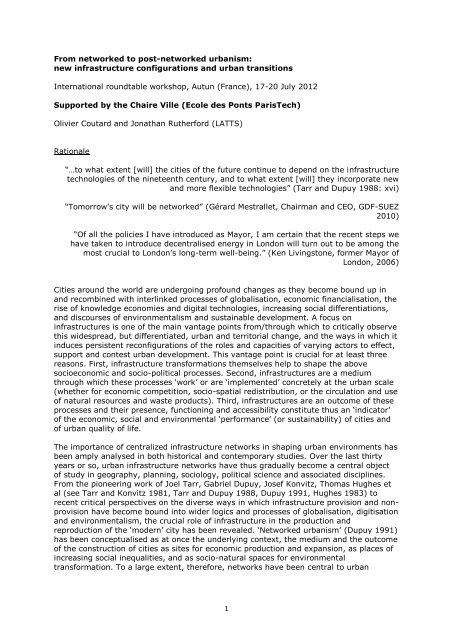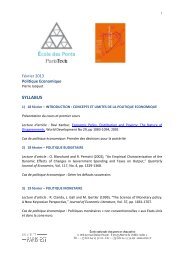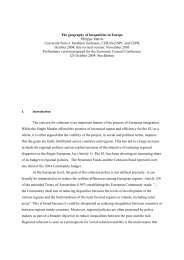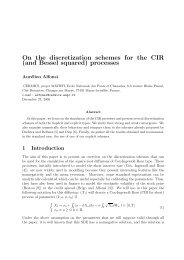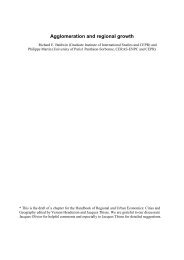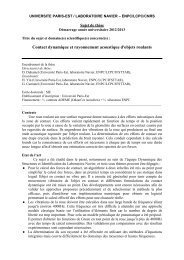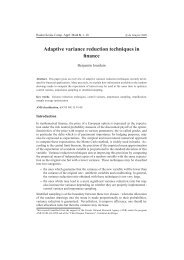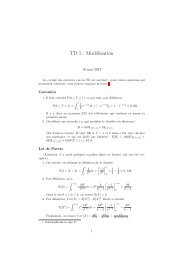From networked to post-networked urbanism: new ... - ENPC
From networked to post-networked urbanism: new ... - ENPC
From networked to post-networked urbanism: new ... - ENPC
You also want an ePaper? Increase the reach of your titles
YUMPU automatically turns print PDFs into web optimized ePapers that Google loves.
<strong>From</strong> <strong>networked</strong> <strong>to</strong> <strong>post</strong>-<strong>networked</strong> <strong>urbanism</strong>:<br />
<strong>new</strong> infrastructure configurations and urban transitions<br />
International roundtable workshop, Autun (France), 17-20 July 2012<br />
Supported by the Chaire Ville (Ecole des Ponts ParisTech)<br />
Olivier Coutard and Jonathan Rutherford (LATTS)<br />
Rationale<br />
“…<strong>to</strong> what extent [will] the cities of the future continue <strong>to</strong> depend on the infrastructure<br />
technologies of the nineteenth century, and <strong>to</strong> what extent [will] they incorporate <strong>new</strong><br />
and more flexible technologies” (Tarr and Dupuy 1988: xvi)<br />
“Tomorrow’s city will be <strong>networked</strong>” (Gérard Mestrallet, Chairman and CEO, GDF-SUEZ<br />
2010)<br />
“Of all the policies I have introduced as Mayor, I am certain that the recent steps we<br />
have taken <strong>to</strong> introduce decentralised energy in London will turn out <strong>to</strong> be among the<br />
most crucial <strong>to</strong> London’s long-term well-being.” (Ken Livings<strong>to</strong>ne, former Mayor of<br />
London, 2006)<br />
Cities around the world are undergoing profound changes as they become bound up in<br />
and recombined with interlinked processes of globalisation, economic financialisation, the<br />
rise of knowledge economies and digital technologies, increasing social differentiations,<br />
and discourses of environmentalism and sustainable development. A focus on<br />
infrastructures is one of the main vantage points from/through which <strong>to</strong> critically observe<br />
this widespread, but differentiated, urban and terri<strong>to</strong>rial change, and the ways in which it<br />
induces persistent reconfigurations of the roles and capacities of varying ac<strong>to</strong>rs <strong>to</strong> effect,<br />
support and contest urban development. This vantage point is crucial for at least three<br />
reasons. First, infrastructure transformations themselves help <strong>to</strong> shape the above<br />
socioeconomic and socio-political processes. Second, infrastructures are a medium<br />
through which these processes ‘work’ or are ‘implemented’ concretely at the urban scale<br />
(whether for economic competition, socio-spatial redistribution, or the circulation and use<br />
of natural resources and waste products). Third, infrastructures are an outcome of these<br />
processes and their presence, functioning and accessibility constitute thus an ‘indica<strong>to</strong>r’<br />
of the economic, social and environmental ‘performance’ (or sustainability) of cities and<br />
of urban quality of life.<br />
The importance of centralized infrastructure networks in shaping urban environments has<br />
been amply analysed in both his<strong>to</strong>rical and contemporary studies. Over the last thirty<br />
years or so, urban infrastructure networks have thus gradually become a central object<br />
of study in geography, planning, sociology, political science and associated disciplines.<br />
<strong>From</strong> the pioneering work of Joel Tarr, Gabriel Dupuy, Josef Konvitz, Thomas Hughes et<br />
al (see Tarr and Konvitz 1981, Tarr and Dupuy 1988, Dupuy 1991, Hughes 1983) <strong>to</strong><br />
recent critical perspectives on the diverse ways in which infrastructure provision and nonprovision<br />
have become bound in<strong>to</strong> wider logics and processes of globalisation, digitisation<br />
and environmentalism, the crucial role of infrastructure in the production and<br />
reproduction of the ‘modern’ city has been revealed. ‘Networked <strong>urbanism</strong>’ (Dupuy 1991)<br />
has been conceptualised as at once the underlying context, the medium and the outcome<br />
of the construction of cities as sites for economic production and expansion, as places of<br />
increasing social inequalities, and as socio-natural spaces for environmental<br />
transformation. To a large extent, therefore, networks have been central <strong>to</strong> urban<br />
1
transitions initiated in cities around the world (but particularly in the North: see below)<br />
over the last one hundred and fifty years.<br />
The last decade or so has been particularly fecund for both empirical and theoretical<br />
social science studies on urban infrastructure networks highlighting their centrality <strong>to</strong><br />
urban questions (and vice versa). These studies have analysed the relationship between<br />
the provision of network services, access <strong>to</strong> these services and the functioning of urban<br />
spaces in a diversity of contexts in both the North and South.<br />
Empirical observations from Southern cities (mainly on water) have indeed largely<br />
contributed <strong>to</strong> advancing and rethinking urban infrastructure studies on a global level in<br />
recent years (see, for example, Bakker 2003, Jaglin 2005, Swyngedouw 2004, the<br />
contributions <strong>to</strong> Coutard 2008). They have in particular explored the widespread urban<br />
implications of the absence or the dysfunctioning of large technical systems for access <strong>to</strong><br />
essential services, underscoring both how the ‘modern infrastructural ideal’ has rarely<br />
been achieved in cities of the South and indeed how this Northern ideal and construction<br />
is problematic in its transposition <strong>to</strong> a very different set of diverse urban contexts in the<br />
South.<br />
At the same time, these recent studies on the technological fabric of the city in the North<br />
and South have been underpinned by a wide variety of theoretical approaches: urban<br />
political ecology (Heynen, Kaika and Swyngedouw 2006, Monstadt 2009), ‘cyborg<br />
urbanisation’ (Gandy 2005, Mitchell 2003), STS (Coutard, Hanley and Zimmerman 2005,<br />
Coutard and Guy 2007), the shifting boundaries of urban politics and governance (Lorrain<br />
2005, Lorrain 2003, Offner 2000, McFarlane and Rutherford 2008), urban fragmentation<br />
(Graham and Marvin 2001, Coutard 2008, Moss 2008), consumption (van Vliet, Chappells<br />
and Shove 2005), environmental resilience (Hodson and Marvin 2009), <strong>post</strong>colonialism<br />
(Bond 2000, McFarlane 2008)…<br />
Beyond a need <strong>to</strong> take s<strong>to</strong>ck of the multiplication of work around urban infrastructure,<br />
the rationale for this workshop is based on two arguments about recent, ongoing<br />
changes in infrastructure provision around the world and about the evolution of social<br />
scientific studies of infrastructure over the last three decades, both of which point <strong>to</strong> an<br />
urgent need <strong>to</strong> reflect a<strong>new</strong> on the forms, meanings and implications of urban<br />
infrastructure and the studies produced thereof.<br />
First, the focus on ‘the rise of <strong>networked</strong> cities’ in the 1980s (cf. Tarr and Dupuy 1988)<br />
has steadily given way <strong>to</strong> research on the limits or indeed the regressive effects of<br />
infrastructure (cf. 'splintering <strong>urbanism</strong>': Graham and Marvin 2001, 'the purga<strong>to</strong>ry of<br />
networks': Dupuy 2011), and recently <strong>to</strong> work on the need for resilience and security <strong>to</strong><br />
protect urban infrastructures (cf. Hodson and Marvin 2009) or ‘when infrastructures fail’<br />
(cf. Graham 2009). Faced with this evolution (from reticularity <strong>to</strong> splintering <strong>to</strong><br />
disruption), we argue from a practical and pragmatic standpoint that we now need <strong>to</strong><br />
discuss where urban infrastructure studies goes from here. If infrastructure serves only<br />
<strong>to</strong> fragment and <strong>to</strong> produce crisis in differing contexts, in what sense and in what ways<br />
can we talk about its ‘urban’ dimensions Can we (and indeed should we) critically<br />
explore whether and how analysis of urban infrastructure can ‘put the city back <strong>to</strong>gether’<br />
(in an analytical sense)<br />
Second, urban infrastructure is itself in constant flux. In northern urban contexts, the<br />
‘traditional’ model of the large technical system rolled out efficiently and harmoniously<br />
between and within cities for water and energy supply and wastewater removal is<br />
contested on the grounds of its incompatibility or unsustainability with regard <strong>to</strong> <strong>new</strong><br />
financial arrangements, political and institutional functioning, individualised lifestyles and<br />
increasing concern for environmental resource use and impact. In southern urban<br />
contexts, it is far from clear that the ‘network’ model based on the North is feasible<br />
and/or even always () desirable for extending access <strong>to</strong> basic services <strong>to</strong> urban<br />
populations. New (and/or old) forms of technological service provision are emerging at<br />
2
the margins of, in the interstices of, or simply in place of existing (or absent) centralised<br />
infrastructure networks. The resulting hybrid socio-technical systems have tremendous<br />
implications for urban development, urban functioning and everyday life in cities in<br />
general (on this point: cf. Coutard and Rutherford 2011).<br />
It is the intersection of these two points – re<strong>new</strong>ing infrastructure, re<strong>new</strong>ing studies of<br />
infrastructure – that we wish <strong>to</strong> focus on in this workshop. We therefore propose an open<br />
and constructive discussion around <strong>post</strong>-<strong>networked</strong> <strong>urbanism</strong> in its dual sense: (a) as a<br />
set of evolving urban configurations and practices which demand analysis of <strong>new</strong> forms<br />
of ‘decentralised’ infrastructure systems and their articulation and recombination with<br />
traditional large centralised systems, and (b) as a richly evolving sub-discipline which<br />
demands exploration of the state and the future for urban infrastructure studies in the<br />
wake of the ongoing dominance of analytical frameworks of ‘splintering’, ‘disruption’,<br />
‘failure’, ‘security’, etc.<br />
Questions, issues<br />
We suggest below an indicative list of issues of interest for the workshop:<br />
‣ How are current urban infrastructure configurations and policies his<strong>to</strong>rically<br />
founded or shaped<br />
‣ What can we learn from past configurations (and reconfigurations...) for<br />
contemporary or prospective processes<br />
‣ In what ways and <strong>to</strong> what extent do common, global infrastructure models and<br />
regimes ‘<strong>to</strong>uch down’ differently in different kinds of cities (North and South,<br />
‘global’ cities and smaller cities, central and periurban…) What distinctions can be<br />
identified between these cities in terms of their available capacities, responses,<br />
policies, repercussions, etc Do cities continue <strong>to</strong> be differently positioned in<br />
relation <strong>to</strong> infrastructure and infrastructure issues by their specificities, contexts,<br />
political arrangements, etc How can we theorise across different cases and in<br />
different urban contexts<br />
‣ How are infrastructures being mobilized as <strong>to</strong>ols/mechanisms/instruments for<br />
urban policies with broader objectives and remits What types of (financial,<br />
economic, political…) <strong>to</strong>ols/mechanisms/instruments are combined in urban<br />
infrastructure development <strong>to</strong> promote and contest the roll-out, superposition and<br />
maintenance of technical networks<br />
‣ How are alternative, ‘decentralised’ technology and service provision being<br />
developed in cities How are they being combined in<strong>to</strong> existing network systems<br />
What are the rationales and fac<strong>to</strong>rs underpinning these infrastructure transitions<br />
Who initiates, controls and shapes these transitions, and for whose benefit<br />
‣ How are environmental and ecological discourses being used <strong>to</strong> create<br />
opportunities for <strong>new</strong> forms of infrastructure<br />
‣ What are the financial/economic, socio-spatial, political/institutional and<br />
environmental implications of shifts in urban infrastructure provision How do<br />
these differing implications relate and produce <strong>new</strong> tensions and conflicts<br />
‣ Who are the winners and losers of urban infrastructure change, and how might we<br />
work <strong>to</strong>wards more socially just and politically inclusive infrastructure<br />
configurations<br />
‣ What are the urban policy ramifications of infrastructure change<br />
‣ What do <strong>new</strong> infrastructure configurations or processes of infrastructure change<br />
imply for theories of ‘the city’, ‘the urban’ and terri<strong>to</strong>rial systems (in North and<br />
South)<br />
3
References<br />
Bakker, K. (2003) Archipelagos and networks: urbanisation and water privatisation in the<br />
South. Geographical Journal, 169, 328-341.<br />
Bond, P. 2000. Cities of Gold, Townships of Coal. Tren<strong>to</strong>n Asmara: Africa World Press.<br />
Coutard, O. 2008. Placing Splintering Urbanism. 1815-1950. Geoforum.<br />
Coutard, O. & S. Guy (2007) STS and the City: Politics and Practices of Hope. Science,<br />
Technology, & Human Values, 32, 713-734.<br />
Coutard, O., R. Hanley & R. Zimmerman. 2005. Sustaining Urban Networks: The Social<br />
Diffusion of Large Technical Systems. London: Routledge.<br />
Coutard, O. & J. Rutherford. 2011. Post-<strong>networked</strong> cities: recombining infrastructural,<br />
ecological and urban transitions. In Cities and Low Carbon Transitions, eds. H. Bulkeley,<br />
V. Castan Bro<strong>to</strong>, M. Hodson & S. Marvin, 107-125. London: Routledge.<br />
Dupuy, G. 1991. L'Urbanisme des Réseaux: Théories et Méthodes. Paris: Armand Colin.<br />
Dupuy, G. (2011) Fracture et dépendance : l'enfer des réseaux Flux, 83.<br />
Gandy, M. (2005) Cyborg urbanization: complexity and monstrosity in the contemporary<br />
city. International Journal of Urban and Regional Research, 29, 26-49.<br />
GDF-SUEZ. 2010. Cities of Tomorrow: Rediscovering Energy. ed. G. S. International<br />
Relations Direc<strong>to</strong>rate. Paris: GDF SUEZ.<br />
Graham, S. 2009. Disrupted Cities: When Infrastructures Fail. London: Routledge.<br />
Graham, S. & S. Marvin. 2001. Splintering Urbanism: Networked Infrastructures,<br />
Technological Mobilities and the Urban Condition. London: Routledge.<br />
Heynen, N., M. Kaika & E. Swyngedouw. 2006. In the Nature of Cities: Urban Political<br />
Ecology and the Politics of Urban Metabolism. London: Routledge.<br />
Hodson, M. & S. Marvin (2009) Urban Ecological Security: A New Urban Paradigm<br />
International Journal of Urban and Regional Research, 33, 193-215.<br />
Hughes, T. 1983. Networks of Power: Electrification in Western Society, 1880-1930.<br />
London: Johns Hopkins University Press.<br />
Jaglin, S. 2005. Services d’eau en Afrique subsaharienne : la fragmentation urbaine en<br />
question. Paris: CNRS Editions.<br />
Lorrain, D. (2003) Gouverner 'dur-mou': neuf très grandes métropoles. Revue française<br />
d'administration publique, 107, 447-454.<br />
Lorrain, D. (2005) Urban capitalisms: European models in competition. International<br />
Journal of Urban and Regional Research, 29, 231-267.<br />
McFarlane, C. (2008) Governing the Contaminated City: Infrastructure and Sanitation in<br />
Colonial and Post-Colonial Bombay. International Journal of Urban and Regional<br />
Research, 32, 415-435.<br />
4
McFarlane, C. & J. Rutherford (2008) Political Infrastructures: Governing and<br />
Experiencing the Fabric of the City. International Journal of Urban and Regional<br />
Research, 32, 363-374.<br />
Mitchell, W. 2003. Me++: The Cyborg Self and the Networked City. London: MIT Press.<br />
Monstadt, J. (2009) Conceptualizing the political ecology of urban infrastructures:<br />
insights from technology and urban studies. Environment and Planning A, 41, 1924-<br />
1942.<br />
Moss, T. (2008) ‘Cold spots’ of Urban Infrastructure: ‘Shrinking’ Processes in Eastern<br />
Germany and the Modern Infrastructural Ideal. International Journal of Urban and<br />
Regional Research, 32, 436-451.<br />
Offner, J.-M. (2000) 'Terri<strong>to</strong>rial deregulation': local authorities at risk from technical<br />
networks. International Journal of Urban and Regional Research, 24, 165-182.<br />
Swyngedouw, E. 2004. Social Power and the Urbanization of Water: Flows of Power.<br />
Oxford: Oxford University Press.<br />
Tarr, J. & G. Dupuy. 1988. Technology and the Rise of the Networked City in Europe and<br />
America. Philadephia: Temple University Press.<br />
Tarr, J. & J. Konvitz. 1981. Patterns in the Development of the Urban Infrastructure. In<br />
American Urbanism, eds. H. Iette & Z. Miller. New York: Greenwood Press.<br />
van Vliet, B., H. Chappells & E. Shove. 2005. Infrastructures of Consumption:<br />
Environmental Innovation in the Utility Industries. London: Earthscan.<br />
5


